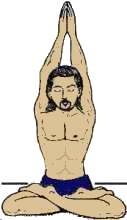| |
 |
apid |
Just what you need to know! |
| eview |
|

Basic Facts about the Yoga Posture (Asana)
The Mountain Posture (whose original Indian name is Parvatasana) in Yoga is suitable for reducing arthritic aches in the shoulders as well as for stretching the upper body.
Note that Parvata means Mountain. The posture gets its name because the person performing it resembles a Mountain with the raised arms denoting the peak.
Stepwise Technique 
- Sit on the ground with your head and spine erect. Extend your legs forward such that your knees and heels are placed together. With the help of your hands, place your right foot on the left thigh and then your left foot on the right thigh. Try to touch the knees to the ground and turn the soles of your feet upwards. See the Lotus Posture (Padmasana) for more details.
- Bring your palms together overlapping the fingers of your hands. Starting at the chest level, extend your arms slowly upwards along the central vertical axis of the body till they are over your head. Ensure that your arms touch your ears and are not bent at the elbows. Ascertain that your upper body is fully but comfortably stretched from the hips to the fingers.
- Remain in this final posture breathing deeply and uniformly with your eyes closed for about 1-2 minutes (in the early stages) or your breakpoint*. Increase this time gradually.
- Repeat the above steps except that you place your left foot on the right thigh and then your right foot on the left thigh. This will ensure that both legs are built uniformly.
Tips and Comments
- You may choose to bend your head forward and place your chin on your upper chest, if you feel comfortable. However, your spine must be erect.
- The hands should be stable without any tremble, and the palms should touch each other without any pressure.
- In the early stages, you may experience pain in the knees and may be able to place only one foot comfortably on the thigh. Therefore, you may wish to try the Half Lotus Posture (Ardha Padmasana) as a preparatory exercise. Regular practice will make the process of placing both feet on the thighs easier. Beginners with rigid knees and/or ankles should proceed with care.
- Instead of keeping the eyes closed, you may focus on the nose tip (Nasagra Drishti) or between the eyebrows (Bhrumadhya Drishti).
- There is also a variation of this yoga posture in which you interlock the fingers and stretch the arms vertically up over the head with the palms facing upwards.
- *Breakpoint is the time upto which you can comfortably remain in a yoga posture. It varies from individual to individual depending on one's fitness, age and will power.
Potential Benefits of the Yoga Posture (Asana)
- The Mountain Posture (Parvatasana) helps in sublimating the vitality in the performer's body because of the total stretch of the vertebral region. Further, the spine is straightened with height gain observed in children and adolescents.
- The posture develops various muscles (biceps, triceps, and brachioradialis) of the arms.
- The deep and uniform breathing in this yoga pose helps the performer freely expand the lungs and chest. Thus, it benefits those with respiratory disorders such as asthma.
Disclaimer : Syvum makes no representations or warranties of any kind, express or implied, as to the correctness of the content as well as the accuracy and use of the information regarding the practice of Yoga. It is strongly advised that you consult your physician before engaging in any physical activities. The information herein is not intended to substitute professional medical opinion or qualified Yoga instructors' opinion. To the full extent permissible by applicable law, Syvum disclaims all warranties, express or implied, including but not limited to, implied warranties and fitness for a particular purpose. Syvum will not be liable for any damages of any kind arising from the use of the information regarding the practice of Yoga, including but not limited to direct, indirect, incidental, punitive and consequential damages.
|
|

